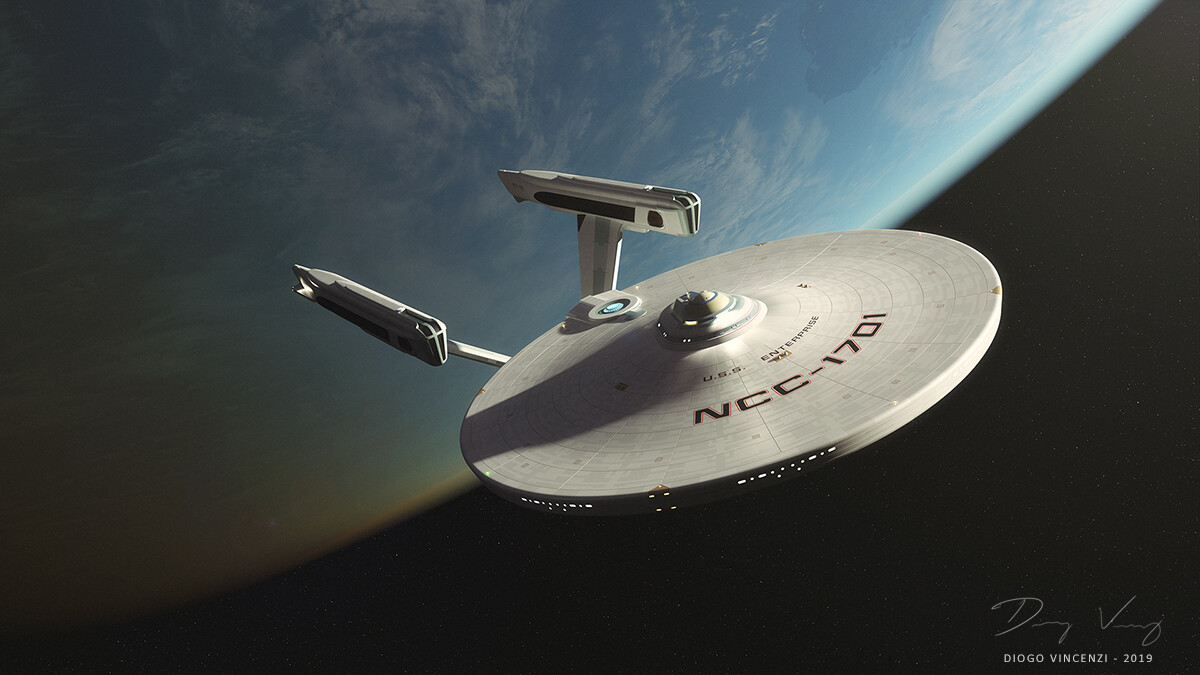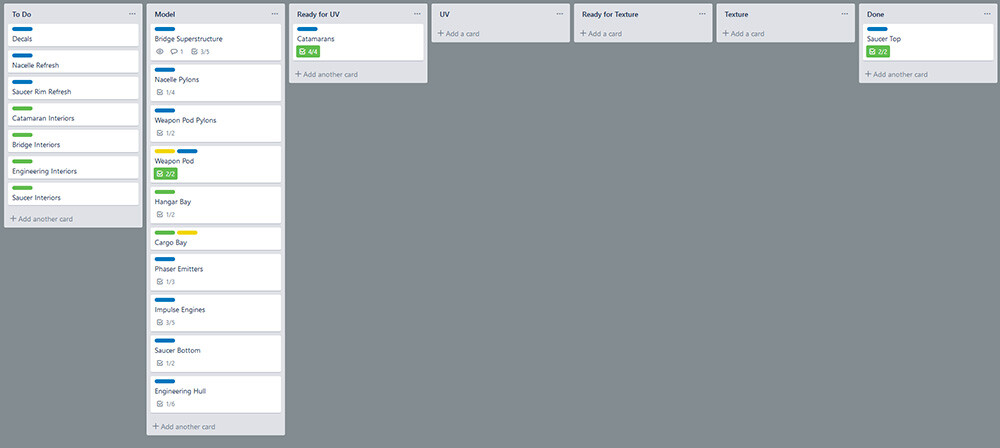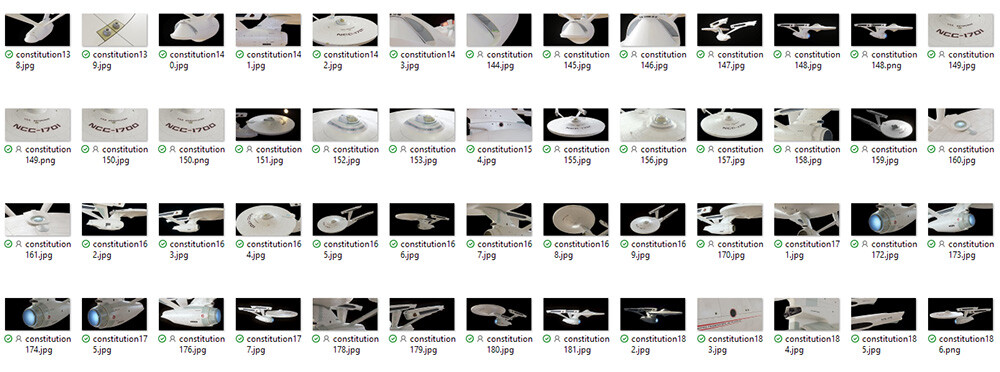If you are a hobbyist, you probably have a huge pile of projects that are in various stages of progress. Some are experiments, some are ideas that needed blocking, but some are projects that you eventually want to see done. Since this isn't my day job, I am in the privileged position of not having to care about trends. So recently I decided that what I really liked doing was Sci-Fi scenes, specifically Star Trek fan art. The thing about Star Trek is that it's highly technical work requiring a high level of attention to detail and precision. It's also time consuming and not unusual to have a project take several months and sometimes even years to finish. So how do you keep focus on a single project for a long period of time, and more importantly, how do you stay motivated?
This year I finished a project that I wanted to do for a couple of decades. A recreation of the USS Enterprise as seen in the Star Trek: The Motion Picture. I started working on it in late 2017. By mid 2018 I had some good progress, but I was burned out. Part of it was a technical issue that I couldn't find a way to solve, but the other part was just lack of interest. I also had set a personal deadline to get it done, and got frustrated when I didn't achieve that deadline. All that can be a huge motivation killer. Early this year I re started the project from scratch and was done with the whole thing after 2 and a half months. What changed?
Project Management
In part, I wasn't hindered by technical issues anymore but the main reason was that I made a list of every single thing I needed to do in the project to have it completed and setup a Trello board to keep track of everything. I also did not set a deadline. It would be done whenever I finished all the tasks.
The USS Enterprise model in its finished state
Trello is a basic implementation of the Kanban method. It can be used for several things, but one of the most famous uses of it is Agile Software Development. As a web developer, I've been using Agile for several years and it clicked that I should use the same for my CG projects. So I listed things like model engines, finish details on bridge, texture bridge, etc. and created 3 columns: To-do, In Progress and Done. This allowed me, each day, to keep track of what I was working on, what still needed to be done and most importantly what I had already accomplished. Seeing that Done column getting bigger is a huge boost. And as the To Do list gets smaller, you get more motivated to finish the project. But, after I finished the project, I started to think my board was a bit of a mess. So now that I moved on to a new project, I setup a new board and came up with a different structure:
Trello board for my current project
As you can see, this is a more complete workflow. It also cuts down on the amount of tasks, as before I was also creating tasks for uv mapping and texturing. Now those parts are reflected on the stage they are in. You also don't need to stay confined to the complete workflow. For instance, after I finish the models of the Phaser Emitters I'll just move them to done as they will only use a shader without textures. The ready for UV and ready for Texture columns are there to help me track which ones I have started and which I haven't.
Obviously, this is my workflow and for some projects you might want to cut the number of columns or you might need more. Since my models are high resolution and don't really care about poly count, I don't need a retopology step. But if you do, just create the new column where you feel is appropriate. I'm not sure about characters. That is not something I really got into yet, so I'm not sure how I would break it down. Would be interesting to hear comments on that.
Although you can, I prefer to not set deadlines for each task. I don't like the anxiety that it creates and it can also make you rush a particular thing and it doesn't get done at the same level of quality as the rest of the project. At the same time, you don't want to create a situation where you just completely forget what you are doing. So I keep a tab on my browser with Trello open at all times. Even if I can't work on a project in a particular day, I still take a look to remind myself of where I am at.
Finishing a project is important
I have completed other projects in the past, but none with the same level of complexity as this one and it gave me a big confidence boost knowing that I can go through till the end. I already know that I can finish the next one and I have more lined up. So make sure you do finish at least one large project. It has helped me a lot and I'm sure the same will hold true for you, especially if you are beginning.
To accomplish that, I highly recommend focusing on something that you are passionate about even if it means ignoring industry trends. Leave that for after you have gotten a groove and are feeling more confident. Also be mindful of your skill level. Taking something up that will require a high level of difficulty to start with might leave you in frustration if you can't get the result you want. Although I only have a few artworks published here at Artstation, I've been doing this for 20 years, so I knew my abilities were at least enough to start. I still learned a lot, but it didn't require me to fundamentally change anything I did before. Just different solutions.
Other motivation sources
Now, while I attribute a good part of the success of the project to a good management, there are a few other things that I did that I consider to be very important:
Work in progress renders
Render proper work in progress shots, and lots of them. My wip render folders are always in the hundreds. Going back sometimes and seeing how much you did can be a huge boost.
Some of the wip renders for the Enterprise
Get feedback
Don't wait until you are ready to post on Artstation to see what other people might think. Find a group of artists on forums or social media and post your in progress shots. I highly recommend Discord groups. Getting feedback in real time is great. For my current project, I'm doing a re imagining of another Star Trek ship but in a different style. Having the thoughts of other people helps a lot, especially when I'm stuck in a particular piece and don't know where to go. If you are working on a specific subject like I do, finding a few folks that are also passionate about it can be an incredible source of motivation.
I know it's tough exposing your work early on. But don't be afraid of the feedback. Even if you think the feedback might be wrong, think about it. Ask why it's wrong. If you can't find a good reason, then give it a try. This has happened several times with me over the past few months. I had designed a piece and showed some folks thinking it was final. After their comments, I decided to try a different design and it worked even better.
Side projects
They can be a good way to clear your head but be careful to not shift your focus completely from the main one. If it happens, don't stress about it. Creating stress and pressure on personal pieces can be a big motivation killer. I actually started designing my current project while I was working on the Enterprise. It started as a proof of concept done in a couple of nights, but I kept opening the file again and again. After I had finished the Enterprise, I decided to open it again and see how far I could go. In addition, I have a few kitbashes that I'm doing for fun and because no one ever did them in high quality before. So if I start to get tired of the main project, I just shift to another one for a few days.
Conclusion
I hope this is helpful for other people that also struggle with motivation in their personal projects. I hope it can also help some of the professionals out there. No one is immune to lack of motivation. I appreciate any comments or questions you might have!


